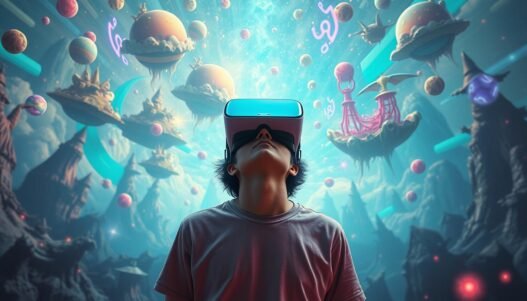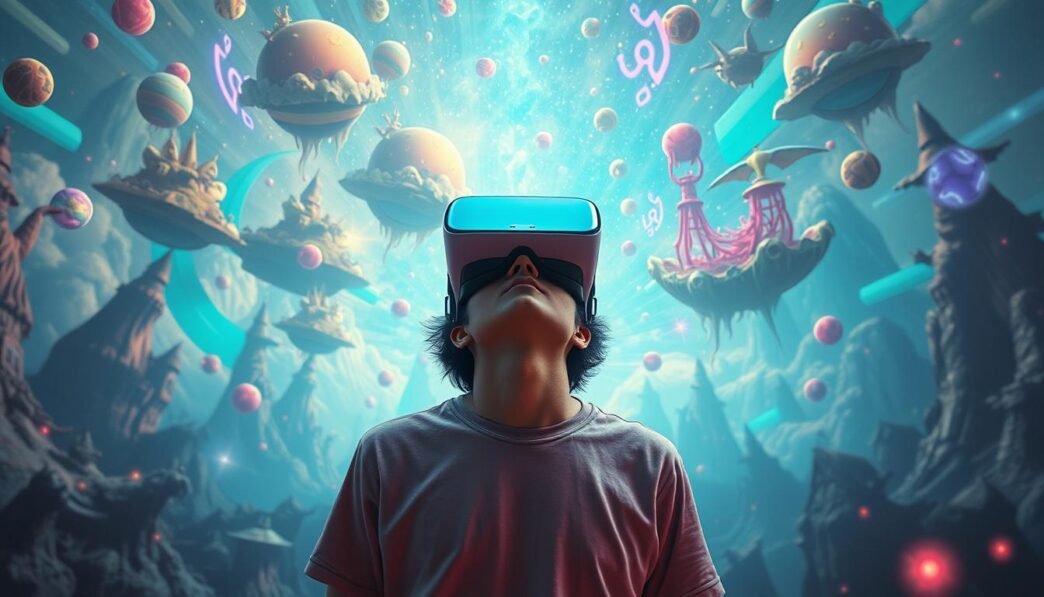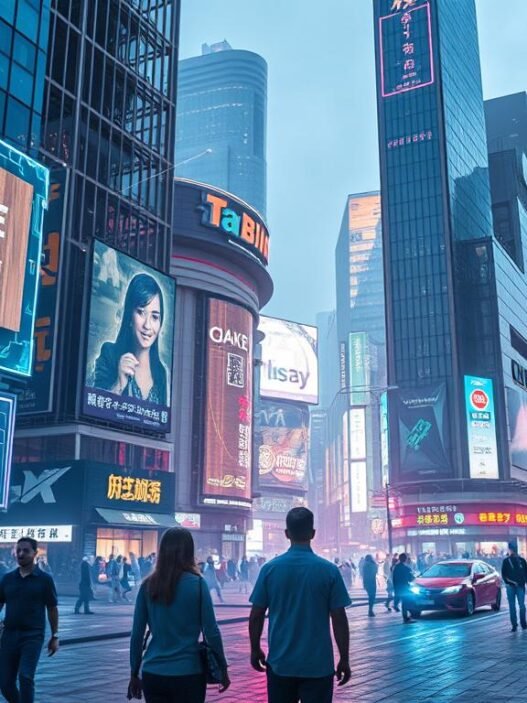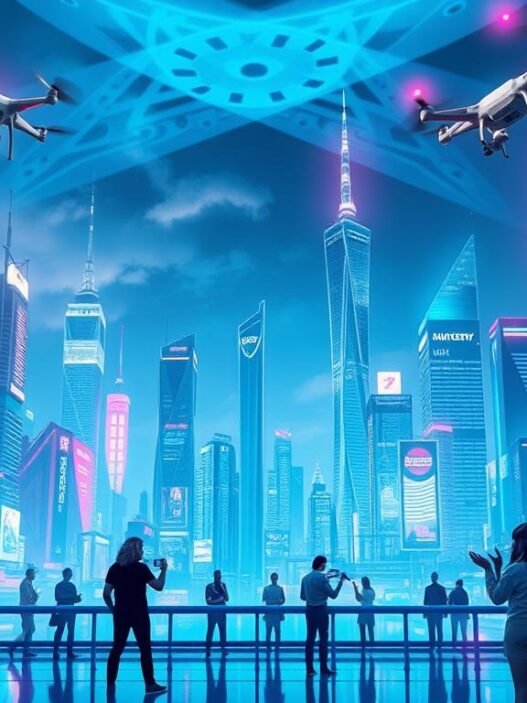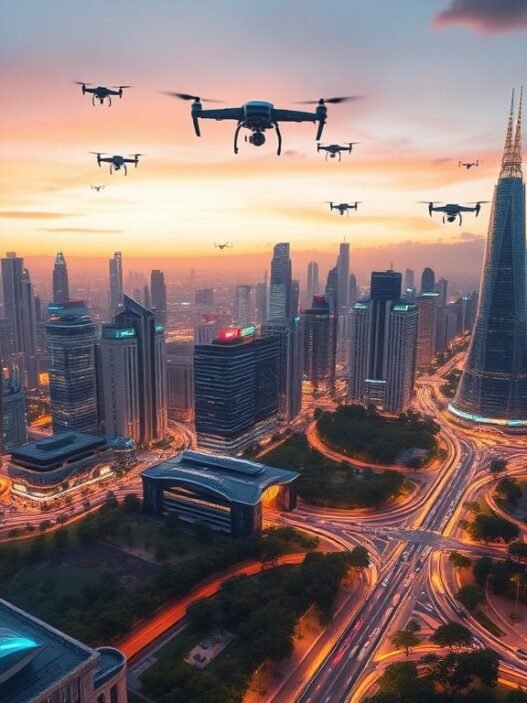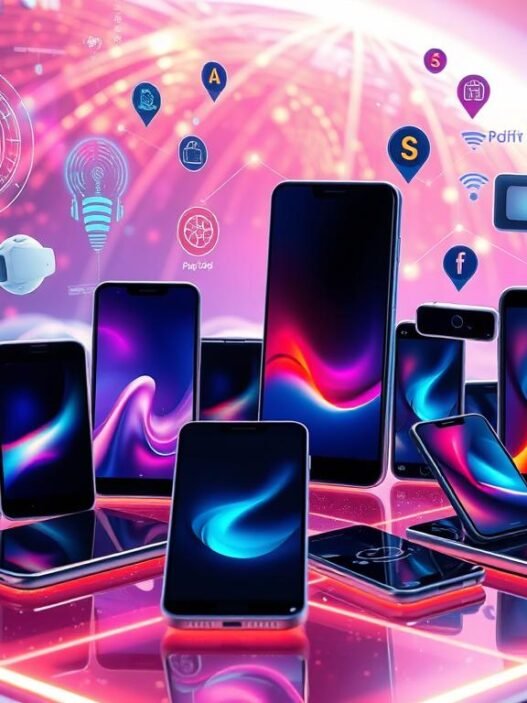Did you know the VR market might hit $62 billion by 2027? This growth shows VR’s major changes in our lives. It affects gaming, education, and healthcare.
VR now goes beyond just fun. It’s real in ways that change how we play, learn, and do tasks. Companies like Virtuix offer awesome products like the Virtuix Omni One. These technologies show why more people are investing in VR and related areas.
VR isn’t just for games at home or fun places. It’s also a powerful tool for learning. VR mixes real and virtual worlds in cool ways. It’s changing how we see and understand everything around us.
Key Takeaways
- Global VR market projected to reach $62 billion by 2027.
- VR technology advancements are transforming entertainment, education, and healthcare.
- Companies like Virtuix are leading innovation with products like the Virtuix Omni One.
- Substantial opportunities exist in indoor playground equipment and VR gaming ventures.
- VR continues to blur the lines between virtual and physical worlds.
The Birth of Virtual Reality
VR started with Sir Charles Wheatstone in 1838. He invented the stereoscope, showing how our brains make 3D images from two 2D ones. This began the explorations into making experiences that feel real.
In 1929, the creation of the Link Trainer by Edward Link changed things. This flight simulator trained over 500,000 pilots in World War II. The 1950s saw Morton Heilig making the Sensorama. This machine could simulate all our senses using 3D displays, smells, and vibrations.
In the early 1960s, Heilig patented the first head-mounted display, the Telesphere Mask. It showed wide-vision 3D imagery but wasn’t interactive. Ivan Sutherland then imagined a virtual world just like the real one in 1965.
By 1968, Sutherland and Bob Sproull created the Sword of Damocles. It was the first VR/AR headset linked to a computer. Despite simple graphics, it showed the power of virtual worlds. Engineers Comeau & Bryan made Headsight, adding motion tracking to VR, around the same time.
The 1970s and 1980s brought even more growth. Myron Krueger’s VIDEOPLACE in 1975 combined digital environments with tracking. By 1977, the Aspen Movie Map from MIT let people virtually visit Aspen, Colorado. This was a hint at what was to come, like Google Street View.
| Year | Innovator | Milestone |
|---|---|---|
| 1838 | Sir Charles Wheatstone | Stereopsis and stereoscope research |
| 1929 | Edward Link | Link Trainer flight simulator |
| 1950s | Morton Heilig | Sensorama |
| 1960 | Morton Heilig | Telesphere Mask |
| 1965 | Ivan Sutherland | Concept of Ultimate Display |
| 1968 | Ivan Sutherland & Bob Sproull | Sword of Damocles |
| 1975 | Myron Krueger | VIDEOPLACE |
| 1977 | MIT | Aspen Movie Map |
VR’s journey from ideas to today’s complex virtual worlds is amazing. Thanks to pioneers like Morton Heilig and Ivan Sutherland. With better computers, graphics, and tracking, VR has grown. It’s now a big part of our lives, both for fun and work.
Immersive Experiences in VR
Virtual reality aims to immerse users in believable environments. This lets people go beyond the real world. The evolution of VR brings groundbreaking headsets and dynamic worlds. These have significantly changed VR experiences over time.
The Evolution of VR Headsets
VR technology started in the 1950s, with notable progress by the late 1980s and 1990s. Now, VR headsets like the Oculus Rift and HTC Vive have high-resolution screens. They also offer precise movement tracking. This makes the VR experience more real than ever. The VR market could hit $27 billion, showing its huge impact across different fields.
Realism and Interactivity
Modern VR stands out for its realistic and interactive settings. These environments have lifelike physics and detailed textures. Users can interact with elements that respond to their movements. This has helped VR grow in gaming, education, healthcare, and architecture. It’s also used in workplaces for training, enhancing customer service, and leadership skills.
Types of Immersive Environments
New VR headsets offer various virtual experiences. Users can explore underwater, space adventures, or join virtual meetings. These cater to many goals like creating digital art, practicing surgery, or enjoying games. VR in education, like Talespin’s platform, offers immersive learning with AI, an extensive library, and analytics.
Applications in Gaming and Entertainment
Virtual reality (VR) is changing how we play games and enjoy entertainment. It brings a new level of realism and interaction. Many VR headsets now have motion controllers and trackers. This lets users dive deep into VR gaming. These improvements have helped reduce lag and nausea, making VR more popular.
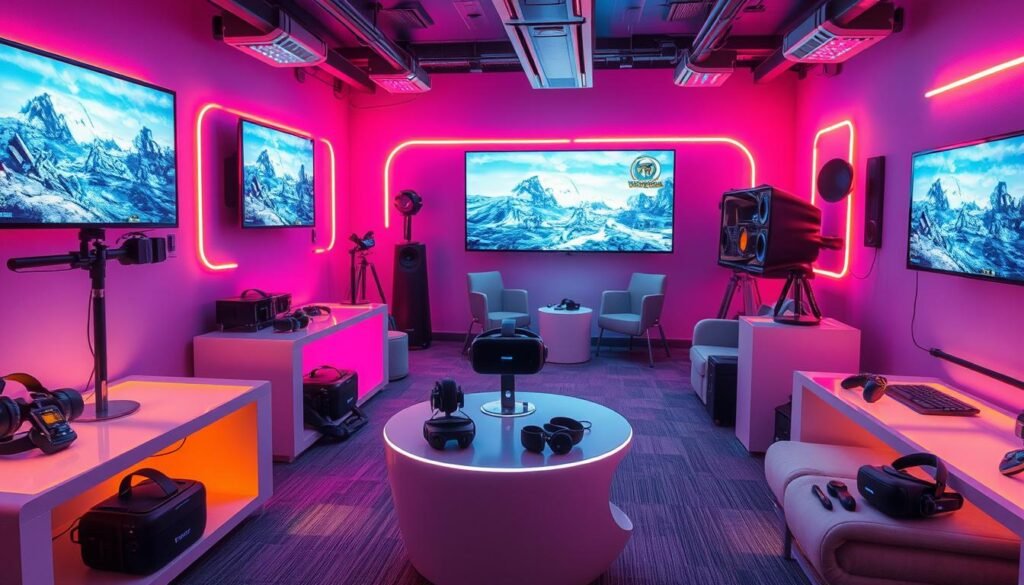
In gaming, VR accessories like steering wheels, haptic suits, and gun stocks make the experience better. When choosing VR gear, think about your budget, if it works with your setup, and the quality of visuals. The Oculus Rift was a big deal in VR. Palmer Luckey made it in 2010, and it came out in 2016. The Oculus Quest, launched by Meta in 2019, pushed VR even further.
The entertainment world is getting into VR for its deep storytelling. Platforms like Google Pay Casinos are adding VR for a fresh take on online gambling. VR movies let viewers become part of the story. Theaters with motion chairs and special effects like smells and wind make you feel like you’re really there.
| Product | Year | Specifications |
|---|---|---|
| Oculus Rift | 2016 | Includes trackers, motion controllers |
| Oculus Quest | 2019 | Standalone headset with hand tracking |
| HTC Vive | 2016 | Room-scale tracking, precision controllers |
| PlayStation VR | 2016 | Compatibility with PlayStation 4 and 5 |
Online casinos are using VR to make a more real casino feel. This makes gaming much better. Also, computer games are a big area for VR. There are all kinds of games, from learning to zombie survival. The fact that 70% of VR headset sales are for gaming shows how popular it is.
The future of VR in gaming and entertainment looks at better user experiences and graphics. Even with challenges like motion sickness and the cost of gear, the push for more real and interactive virtual worlds is strong.
Virtual Reality (VR) in Education
Virtual reality is changing the way we learn by introducing new, exciting methods. It lets us dive into educational content in ways we never thought possible. Using VR, teachers can turn a normal classroom into a dynamic, fun space.
Historical and Cultural Learning
Teaching history and culture has gotten a big boost from virtual educational applications. Now, students can virtually visit important historical sites or explore ancient societies. This way, they get to understand history and cultures more deeply than just reading about them. Google Cardboard and Immersive VR Education are making these amazing experiences more accessible to schools.
Scientific and Practical Training
In subjects like science and vocational studies, VR in learning is incredibly useful. It allows students to do hands-on training without the limits of a real lab. For example, a study in EdTech found that students learning biology with VR did better than those who didn’t. Immersive learning, interestingly, has been shown to boost memory retention by up to 9%. Tools like ClassVR are bringing specialized VR headsets to help with learning in these areas.
Even though VR has many benefits, there are hurdles like costs and the need for top-notch content. Yet, programs like American University’s Master of Arts in Teaching are gearing up teachers to overcome these challenges. With VR, we can spark creativity, simplify tough topics, and make learning better for students of every age.
| Benefits | Challenges |
|---|---|
| Enhanced engagement and retention | High costs |
| Hands-on learning experiences | Equipment bulkiness |
| Cultural competency development | Content quality |
Transforming Healthcare with VR
Virtual reality (VR) has changed many parts of healthcare. It offers new ways to improve medical training and patient care. VR lets doctors practice like they’re in real-life situations. This makes medical care more accurate, quick, and effective.
Surgical Simulations and Training
VR gives medical students and doctors a space to practice surgery without any risks. A study showed that VR training boosted surgical abilities by 230% over old methods. It lets them try difficult surgeries before doing them on real patients. This builds their skills and confidence.
VR also helps in understanding the human body better by showing it in 3D. This method lets students and surgeons see and interact with the body closely. It leads to better care for patients.
Treating Phobias and PTSD
VR therapy is powerful for treating phobias, PTSD, and anxiety. Exposure therapy through VR has helped people face their fears safely, showing a 68% average fear reduction. VR creates realistic situations for patients to safely challenge their fears.
For PTSD, VR helps patients process their trauma with a therapist’s help. This method has greatly reduced symptoms, opening new paths for treating mental health.
Therapeutic Use Cases
VR isn’t just for mental health; it also helps with physical treatments. Cedars-Sinai Hospital found VR can lower pain by 24% or more. For burn victims, VR distraction means less pain and brain activity related to it. VR shows immense promise in reducing pain without always needing drugs.
VR therapy helps children with cerebral palsy and adults with cognitive issues improve their movement and brain functions. Doing rehab in VR is more engaging, which leads to better results. VR’s scope extends to helping people move and think better.
Mixing VR with AI and augmented reality (AR) could further revolutionize healthcare. These combinations might bring new ways to care for patients, train medical staff, and treat various conditions. They pave the way for healthcare’s future.
VR in Architecture and Design
Virtual reality (VR) is changing architecture and design in big ways. With VR in visualization, creators can see and feel their ideas in real size. This happens before building starts. They get a clear look at models in a lifelike 3D space.
Top companies like Zaha Hadid Architects and SHoP Architects are using VR creatively. Zaha Hadid Architects brought VR into the 520 West 28th Street project in New York. This let them explore 3D designs and make smarter decisions. It also made it easier to show their work to clients. SHoP Architects used VR for the 9 DeKalb project. It helped the team work together better, even from far away.
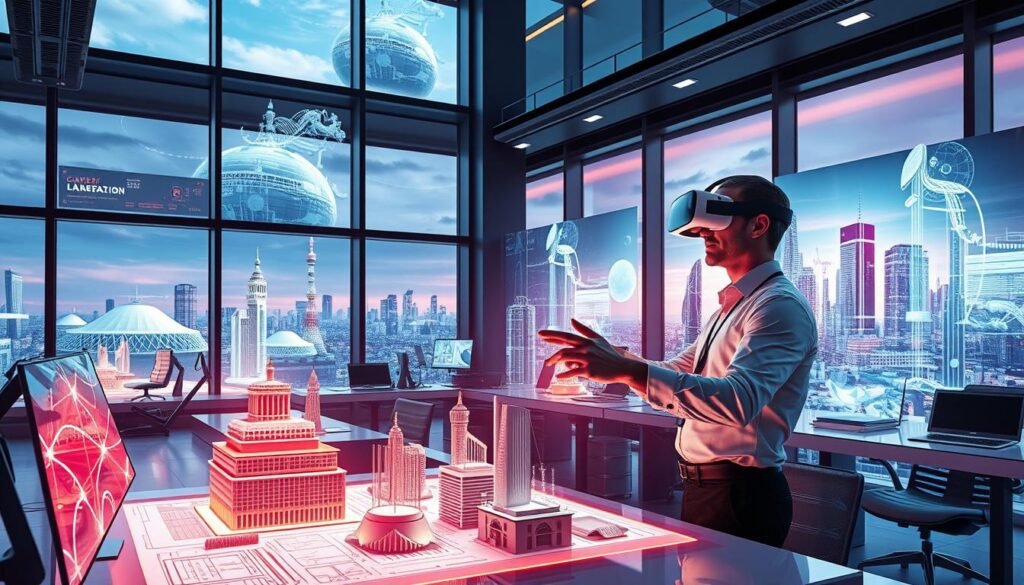
VR is also helping in other big projects. For example, Foster + Partners used it for the Bloomberg European Headquarters in London. Mortenson Construction used VR for a sports arena. VR in these cases made work faster and safer. These stories show that architectural design using VR can make building homes smoother and improve how we talk to clients.
VR is becoming key in teaching architecture too. It helps students learn new and needed skills. They will be ready for a changing work world. VR in education makes it easy to share designs. It also helps in making prototypes quicker.
The Future of Social Interactions in VR
VR social platforms are the future of how we connect. Places like Facebook’s Horizon Venues and vTime XR let us meet and interact in real time. These platforms are made better by tech like AR and spatial computing, making the mix of real and virtual even cooler.
Avatars are how we show ourselves in these virtual places. In worlds like VRChat and AltspaceVR, avatars have fun, interactive adventures. People can build their own places, organize events, and play games. This all happens in a virtual space that goes beyond what we’re used to online.
Big investments in VR, like Meta’s $10 billion each year, are changing how we socialize virtually. Soon, we’ll blend chatting, working together, and socializing in new ways that merge the real and digital. Imagine meetings as holograms and creating communities in mixed reality. This future means joining diverse and inclusive social circles.
But we can’t forget the risks of VR, like fake identities and becoming too dependent. It’s important to balance our virtual and real lives. This balance helps us avoid the downsides of spending too much time in virtual worlds.
| Aspect | Current State | Future Prospects |
|---|---|---|
| Virtual Interactions | Real-time events and meetings | Holographic and mixed reality experiences |
| Virtual Socializing | Avatar-based communication | Personalized digital twins and blockchain integration |
| VR Social Platforms | VRChat, AltspaceVR, Horizon Venues | Enhanced by AR, network improvements for seamless interactions |
The framework of the metaverse, including its network and structure, will get better over time. This will make VR social platforms even more exciting. We’re heading towards a future where connecting and socializing online will be totally different and much more immersive.
Challenges Facing VR Technology
Virtual Reality (VR) has great potential but faces big obstacles. One key problem is the cost. Creating a VR app can cost between $30,000 to $150,000. 65% of people say this is too expensive. High-quality VR hardware costs a lot too, though prices are falling.
Motion sickness is another big challenge in VR. People often feel eye strain, nausea, and dizziness. To fix this, VR needs to run smoothly at 90 frames per second. This effort aims to make VR more comfortable.
Technical challenges also slow down VR’s popularity. Even with new devices like the Meta Quest 3, there’s a need for better tech. The reliance on game engines like Unity shows we need better tools for VR development. Also, learning to use VR takes much longer than traditional methods, which can turn people away.
Cybersecurity and privacy worries are big too. Over half of cell phone users are concerned about these issues. This fear is also true for VR. There’s also the problem of feeling awkward while using VR tech. But, remote and group training methods are making it easier for people to get on board.
To truly tackle these issues, a strategic plan is essential. This includes teaming up with experts, making VR more user-friendly, and constantly improving VR headsets. With predictions saying 23 million jobs will need AR/VR training by 2030, overcoming these challenges is crucial.
| Challenge | Description | Mitigation Efforts |
|---|---|---|
| Cost | Development costs and high hardware prices | Progressive hardware price reduction, streamlined app development |
| Motion Sickness | Symptoms include eye strain, nausea, dizziness | Maintaining frame rates of at least 90 FPS |
| Technical Limitations | Requires robust development platforms | Advancements in hardware and game engines |
| Security Concerns | Concerns about cybersecurity and data privacy | Enhanced security measures in VR systems |
| Emotional Resistance | Users feel self-conscious using technology | Remote and group training options |
Emerging Trends in Virtual Reality
In 2024, VR is changing many industries. The VR market was worth almost USD 60 billion in 2022. By 2030, it’s expected to grow a lot, thanks to new VR technology.
Big steps were taken with Apple’s Vision Pro headsets in February 2024. They mix real and digital worlds. The Meta Quest 3 and Meta Quest Pro are also key for creative people and high-end users.
- Education: VR helps with learning about history and doing practical training. A survey by PwC in 2022 showed VR trainees learn four times faster and feel more confident in their skills.
- Healthcare: There are more uses for VR in surgery simulations, treating phobias, and therapy.
- Entertainment: VR is making gaming and storytelling way more interactive.
- Workplace Collaboration: Using VR and AR is improving how remote teams work together.
- Retail and Marketing: VR changes how people shop with virtual try-ons and immersive experiences.
VR is becoming more democratised. Cheaper tech means even small groups can use VR for learning and training. This is making VR more common in different fields.
Shops are also using VR more. Brands use AR for customers to try things on virtually. VR tools are also making working together online feel more like real life.
Keeping virtual spaces safe is important. As VR gets better, keeping online environments secure is a big focus.
To wrap up, VR trends and technology are creating new experiences. These are changing education, health, shopping, and how we connect with others.
Conclusion
Virtual Reality (VR) has come a long way since the 1960s. It started gaining traction in the consumer market around the late 1980s and early 1990s. Today, VR is breaking new ground in many fields with its endless possibilities.
The technology itself has advanced a lot. We now have VR headsets with crisp displays and precise motion tracking. There are also devices that let us feel virtual objects through haptic feedback. These innovations are truly amazing.
One key area VR is changing is education. It allows immersive learning experiences that were not possible before. Students can explore historical sites or dive into science topics in new ways. In healthcare, VR helps with training and therapy. Surgeons practice complex surgeries, and therapists treat anxiety with it.
In the world of gaming, VR brings a whole new level of immersion. This changes how we play games, making things we thought impossible real. VR is also used for training in aviation, military, and manufacturing. This makes practices safer and more effective.
Yet, VR does face challenges like motion sickness and the need for better content. But, new trends like wireless headsets and combining VR with AR (Augmented Reality) are exciting. These developments promise a bright future for VR. It’s crucial that all involved work together to make VR’s growth positive and responsible.
In conclusion, VR’s future is incredibly bright and offers endless possibilities. It’s set to change the way we learn, heal, game, and live. As VR technology keeps evolving, it will open up new experiences and opportunities. These will surely change our world in fundamental ways.





